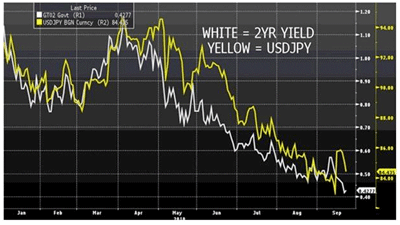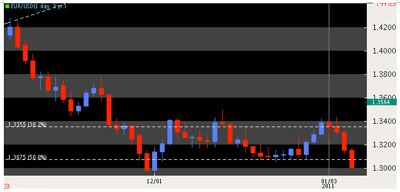Currency traders, be sure to analyze these three markets-each one closely tied to the forex market-for added confirmation and clearer trading signals.
By Richard Lee
Foreign exchange traders, both new and seasoned, heavily focus their trading strategies on technical indicators-moving averages and trend lines-when trading the euro or British pound. And they rarely take a look at other markets for additional hints about market direction. But, these other markets can sometimes make the difference between a profitable position or a losing trade in the foreign exchange market.
For years, professional money managers have looked at secondary markets to confirm positions. Using advanced charting programs, these professionals are able to see relationships between certain markets, revealing movements between investments in the same or different direction. Some of these correlations are commonly known to the market-like crude oil and the Canadian dollar, or gold futures and the Australian dollar. And some are not so common-like the US dollar/Japanese yen exchange rate and the short-term rate on Japanese government bonds.
Let's take a quick peek at some other markets that can offer insights into potential foreign exchange market moves.
Look to Bond Yields
Believe it or not, the currency and bond markets are very closely related.
The direction of both investment assets is widely dependent on a country's economic environment and monetary policy. If an economy is showing strength, global investors will buy bonds that are being offered by a particular country, always looking for stable and high rates of return. This will cause demand for the country's currency to increase, thus appreciating the value of the currency. Global investors interested in investing in the country (and its infrastructure) will always have to transact in the country's currency. The two go hand-in-hand.
This is the reason why money managers will watch short-term bond yield patterns for confirmation of a forming trend in the currency market: A movement in one asset can foretell or confirm the move in another asset.
One currency pair that shows off this relationship is the US dollar/Japanese yen exchange rate. In the FX market, the USD/JPY currency pair moves in relative sync with short-term Japanese government notes, particularly Japan's two-year notes. In Figure 1, we can see the pattern was particularly strong throughout most of 2010. During this time, market speculation had sided with an appreciation in the Japanese yen. With hints of a global recovery surfacing, Japanese exporters were rebounding faster than their US counterparts, thus leading to higher growth in Japan. As a result, global investors betting on better prospects in Asia invested in Japanese short-term debt. The demand helped to boost the Japanese yen's appreciation against the US dollar from May to September 2010.
NEXT: 2 Other Markets FX Traders Should Watch
|pagebreak|Currency Futures
Derivative instruments like currency futures are also great for confirming short-term trends in foreign exchange rates.
In the equity markets, stock brokers and traders will look toward market volume in confirming momentum. Currency traders, instead, will use currency futures open interest in gauging the market's demand for a particular currency. This type of information can be used to predict the future demand not only for currencies, but commodities as well.
Although some analysts or strategists look at both non-commercial and commercial transactions, the key is to look at non-commercial positioning. Non-commercial positioning is usually done by entities that are speculating in the market. The trick here is to see pent-up demand in a particular currency in confirming or hinting at a potential direction in the market (i.e. two-month open interest is high on the Australian dollar). For instance, significant interest in a currency means that a good portion of the market is on one side of the market, thus making the opposite outcome more probable. If every trader is bullish or long on the market, what happens when they all want to sell?
On December 19, 2010, euro bearishness reached a significant 90-day high. Traders were betting on dollar strength as the European Union debt crisis lingered on, and these traders were short euro currency futures. This tidbit coincided with the EUR/USD currency pair falling to a technical support level of $1.3080. Shortly after reaching the level, traders began to take profits, which led to a reversal of sentiment. Euro strength continued in the days after the bullish signal surfaced, creating a 10% return for euro longs.
Credit Default Swap (CDS) Markets
A relatively unknown market prior to the recent financial crisis, credit default swaps, or CDS instruments, can be great in showing long-term sentiment for individual currencies.
Introduced and widely used in the last 14 years, credit default swaps are contracts protecting a buyer's position against a potential credit event. For example, a money manager can insure the creditworthiness of $100 million in Japanese government bonds by paying an insurance premium. In the event of a default or debt crisis, the money manager would be able to recoup the value of their bonds. So, much like currency futures, credit default swaps are a great way of telling how bullish or bearish the market is on a particular currency.
During the European Union debt crisis of 2010, credit default swaps confirmed the market's distaste for European assets, and credit default swaps (or the cost of insurance) shot to record highs. Industrial nations like the United States and Great Britain today enjoy swap rates of 50 basis points, on average. Greek swap rates were over 15 times these rates during the debt crisis. Vast differences between the credit swap rates confirmed bearish sellers in the euro as the currency plummeted by 20% in as little as five-and-a-half months.
Conclusion
When used correctly, these market indicators can add great confirmation to individual trades and boost overall investment return. With the increased interconnectivity of the global markets these days, it pays to understand market relationships.
Related Reading:
- How Forex Correlations Can Help You Make Better Trades
- Use Intermarket Analysis to Find Great Trades
By Richard Lee
Richard Lee is currently a contributing editor of the Daily Reckoning. This article first appeared on Investopedia.com























